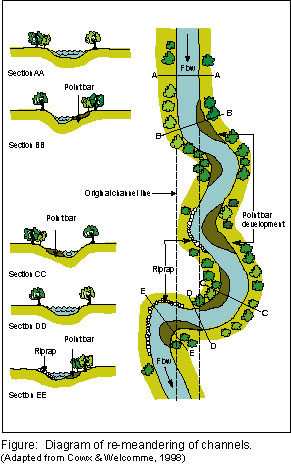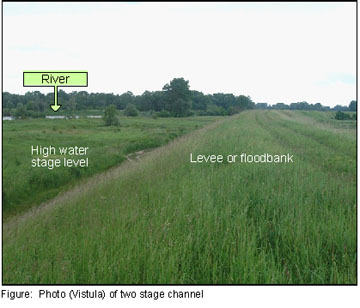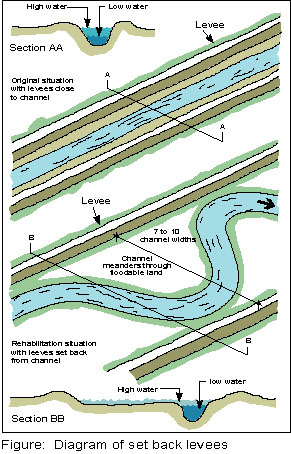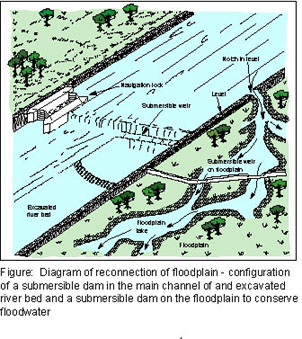Large Scale Restoration
of Channels--
 Most
of the methods described above can be used in small stretches of river,
and especially in comparatively small streams, to produce local improvements
in fish populations. Most of the solutions are also of relatively low
cost. The methods described in this section are more complicated and require
a greater level of investment. The goal is not only to restore channel
diversity, but also to allow the river to develop a lateral expansion
zone that may have some of the characters of a true floodplain.
Most
of the methods described above can be used in small stretches of river,
and especially in comparatively small streams, to produce local improvements
in fish populations. Most of the solutions are also of relatively low
cost. The methods described in this section are more complicated and require
a greater level of investment. The goal is not only to restore channel
diversity, but also to allow the river to develop a lateral expansion
zone that may have some of the characters of a true floodplain.
The simplest approach to the restoration of larger stretches of straight channel is to restore the meander (winding or curving) structure. In the case of river straightening, this can be done by breaking the levees that contain the channel, allowing it to return to its original river bed. More frequently, the former bed of the river has disappeared, and new channels have to be dug artificially.
A second approach is to construct a multi-stage channel by setting back
the levee on one or both sides of the river so that there is a low flow
and a high flow channel.
 |
 |
Levees can be set back even further from the main channel
allowing space in which the river can re-establish its meanders naturally.
Alternatively, engineering solutions can be used to start the river meandering
process. The space between the levees forms a floodplain in which many
of the features, such as backwaters, channels, floodplain lakes and swamps
can develop or be introduced. The plain can also be used for several purposes
including wildlife reserves, reforestation, the grazing of cattle or growing
of crops during the dry season.
As far as possible, channel diversity should be increased by reconnection
of old channels and side arms that were cut off by the old levee structures
close to the river.
Restoration of the Floodplain--
The main objective in reconnecting the floodplain
is to restore lateral connectivity, especially to former floodplain water
bodies that have become isolated from the channel. Restoring lateral connectivity
is important for improving wetland ecosystem function, restoration of
aquatic plant communities and waterfowl habitat, and restoring migration
pathways for fish and other aquatic animals. This usually involves breaking
the levee and actively reconnecting the pool, wetland or channel to the
main channel of the river. A new flood control structure (levee) may have
to be built behind the reconnected waterbody. Sluice gates or submersible
weirs may control flow into and out of the waterbody. The waterbody may
be connected at the upstream and downstream end or at the downstream end
only. The way in which the waterbody is connected affects its ecological
characteristics and the types of vegetation, invertebrates, birds and
fish that eventually colonize the restored habitat.
In addition to reconnection of existing but old floodplain features, new
features can be made by connecting borrow pits, and sand and gravel extraction
sites near to the river. Leaving such sites in a suitable condition for
connection to the river can be a condition of the water extraction license
issued to the developer.
It is equally important to conserve and restore the floodplain itself,
especially where it is (or was) forested. Floodplain forest and mangroves
have high social and economic value to people, and also high environmental
value to the aquatic organisms that depend on them for habitat. They also
contribute to the maintenance of biodiversity of many species of animals
including fish, some of which have become highly dependent on forest products
such as fruit for feeding. The practice of clearing flooded forest and
converting this habitat to rice culture is a serious problem in the Mekong
Basin, particularly along the fringes of the Great Lake in Cambodia. This
loss of habitat has serious repercussions on biodiversity. Therefore,
projects designed to reforest cleared areas are a valuable component of
rehabilitation programmes.
In areas where the floodplain has been separated from the main channel
for a long time, flooding may not occur because the channel bed has been
eroded downwards to a point where the bankfull state is never exceeded.
Two solutions have been used to overcome this difficulty:
submersible dams can be installed across the river raising the level at a particular point from which it can be deflected onto the floodplain;
lowering the level of the floodplain by scraping off the surface layers of soil. In either case, it may be necessary to install submersible weirs across the floodplain to direct the water and retain it as long as possible.
It is clear that the total conservation
of the river system in a pristine state, or even in its current condition,
is unrealistic. The needs for economic and social development will continue
to place demands on the river and its landscape that are not wholly compatible
with the interests of many of the plant and animal species that inhabit
natural floodplains. This means that specific, but limited areas should
be set aside as reserves along the river for the conservation of aquatic
fauna, so long as the linkages between them are preserved. In other rivers,
the idea that the structure of the river and floodplain needs to be restored
or protected in specific areas along the river is termed the 'string of
beads' approach.
It is, however, not enough to simply create reserve areas. These must
be selected according to their significance to species, or groups of species,
as breeding, nursery, feeding and refuge sites. In addition, the pathways
between the various sites must be kept clear so that fish and other aquatic
organisms can move freely between them.
 |
 |